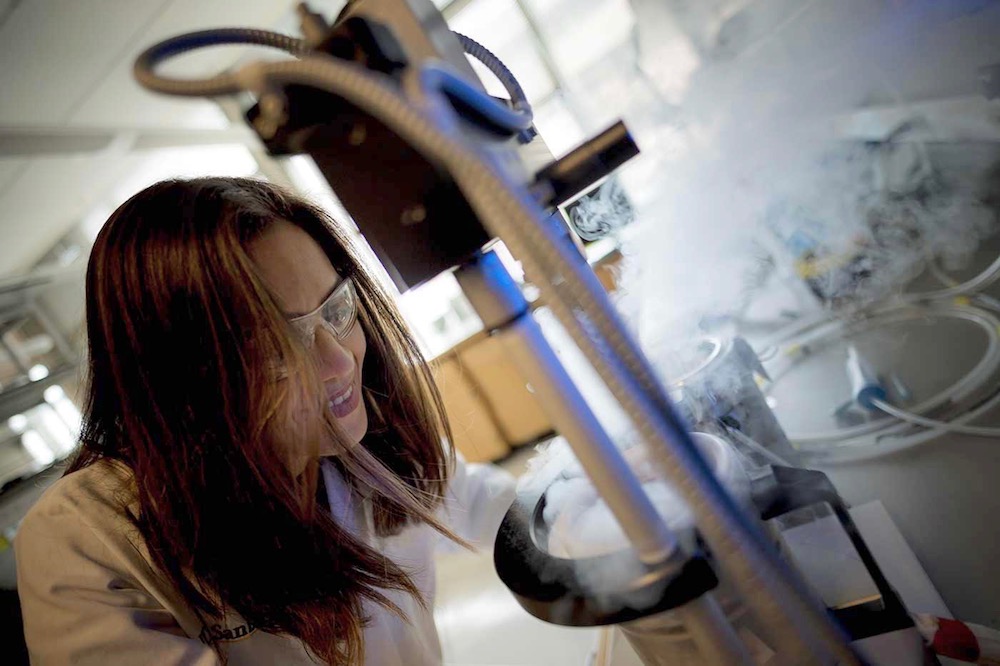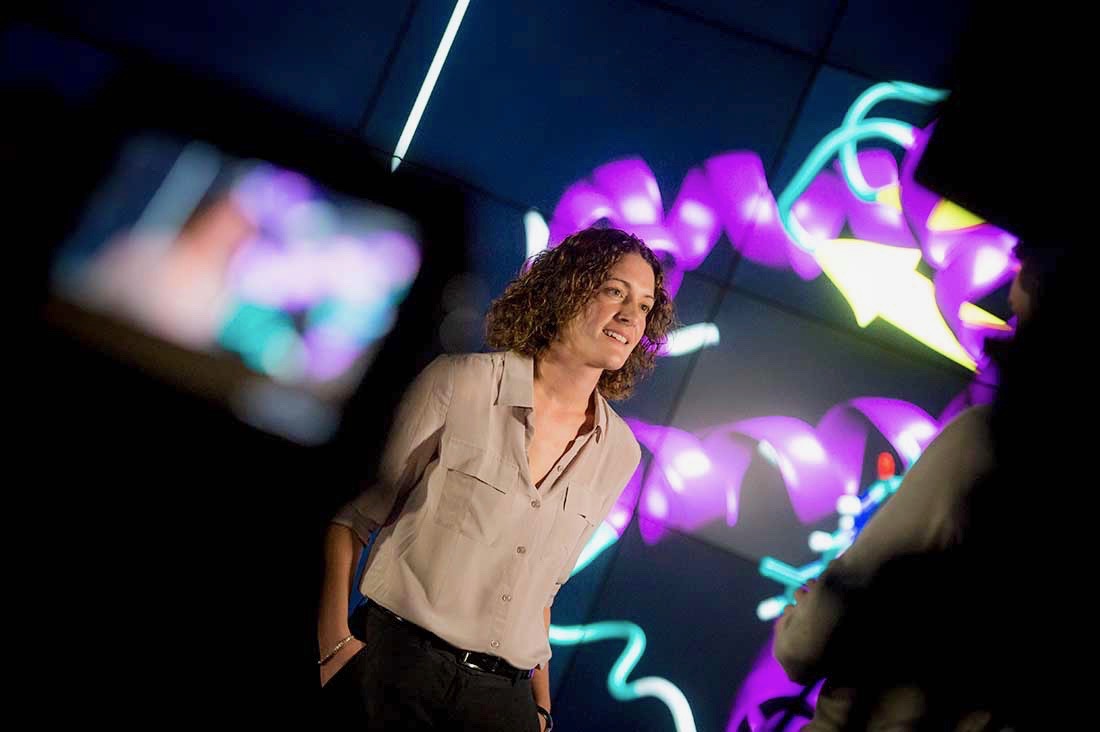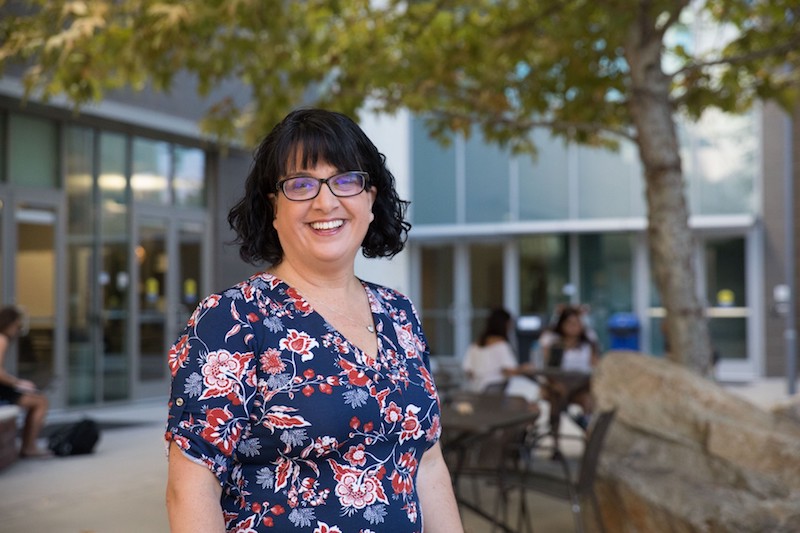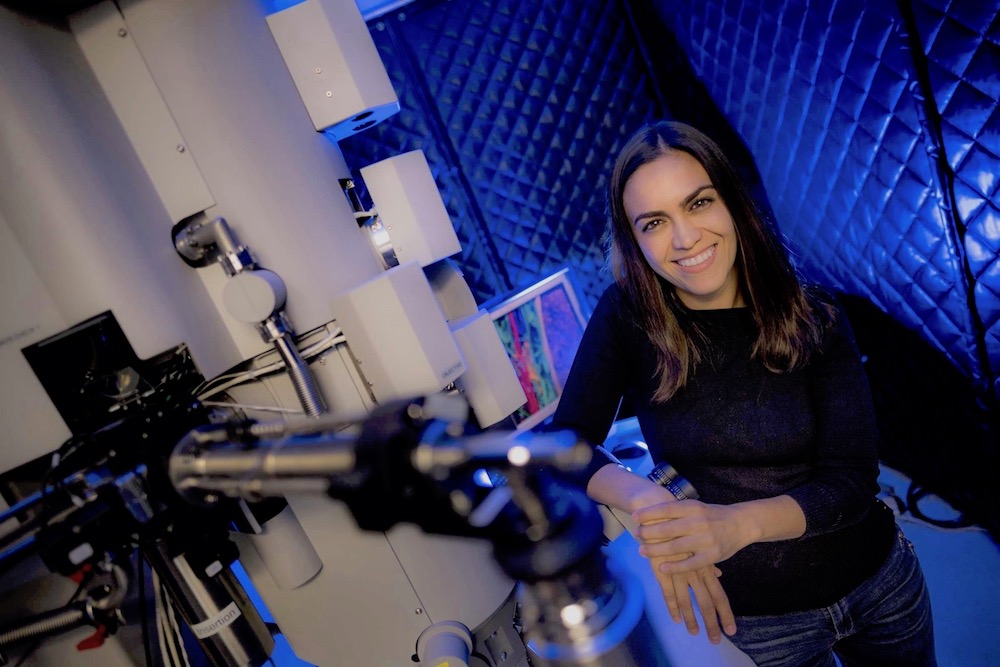Daily Business Report-Nov. 13, 2017
Biophysicist Elizabeth Villa: ‘This university has a lot of really good, strong women scientists. And the senior women and men here are very good at mentoring and supporting each other.’ (Photos by Erik Jepsen/UC San Diego Publications)
Women Rising
Women Scientists at UC San Diego
Have Overtaken Men as Leaders
of the Campus’s Biggest Research Grants
By Kim McDonald | UC San Diego News Center
For Elizabeth Villa, 2017 was a banner year.
Earlier this year, the biophysicist and assistant professor of molecular biology received her first of four years of research funding from the Pew Charitable Trusts following her selection last fall as a Pew scholar. Villa was one of only 22 early-career biomedical researchers nationwide to win the prize.
After submitting a novel proposal to build tools to unveil the architecture of the nucleus and determine how it communicates with the rest of the cell, she acquired $2.3 million in research funding from a prestigious NIH Director’s Innovator Award. She was also awarded, with a senior female faculty member and other collaborators, a multimillion dollar research grant from the National Institutes of Health and a $620,000 Michael J. Fox Foundation research grant.
Villa, who arrived at UC San Diego after a postdoctoral fellowship only three years ago, is part of a group of young faculty on campus whose out-of-the-box approach to solving research problems has allowed them to quickly gain recognition, academic prizes and funding.
She’s also an example of another noteworthy campus trend — female scientists who, despite their minority status in STEM fields, are pulling in the biggest research grants awarded to UC San Diego.
As is the case at other top research universities, women scholars here are in the minority. They account for only 25 percent of the tenure-track faculty and 36 percent of the other research appointments at UC San Diego.
But of the 10 largest grants awarded to researchers on the main campus this year, women serve as the leaders — or principal investigators — for eight of them. In the health sciences, which includes UC San Diego’s medical and pharmacy schools, six of this year’s top 10 grants by dollar amount are headed by women.
It’s not just a one-year spike. Over the past five years, the number of women principal investigators on the 40 biggest research grants awarded to the main campus and health sciences has steadily grown, this year surpassing those led by men.
No one knows for certain why or whether similar trends are occurring at other top research institutions.

“I would be very surprised if you saw the same trend at other universities,” said Villa. “This university has a lot of really good, strong women scientists. And the senior women and men here are very good at mentoring and supporting each other. Since I’ve been here, I can name off the top of my head at least 10 women—as well as many other men—who have approached me and said, ‘How can I help? ’”
“We have a very collaborative culture on this campus and in San Diego generally,” said Kit Pogliano, a professor of molecular biology and Dean of the Graduate Division. She noted that women scientists, in particular, are beginning to excel. “It’s a collaborative place that tries to help everybody succeed. The saying, ‘A rising tide lifts all boats’ is really true in this community.”
That’s not to say gender bias or discrimination doesn’t exist—either implicit or explicit—within our research community.
“Bias is very real in our culture and we need to be vigilant about stamping it out,” said Sandra Brown, Vice Chancellor for Research and a distinguished professor of psychology and psychiatry here since the mid-1990s. “People tend to hire and promote others who look like themselves or come from similar backgrounds.”
However, many scientists including Brown point out that UC San Diego’s relative youth, when compared to other top research institutions, and its growing tradition of hiring and promoting prominent scientists regardless of gender is enabling UC San Diego to advance women in science.
As a newer university, we’ve always had a different culture,” Brown said. “A large proportion of our faculty came here to focus on studying important problems rather than preconceived ideas about traditional disciplines. Such a problem focused approach encourages cross disciplinary and team based research–a context in which our science thrives. That said, we need more women faculty in STEM fields, need to continue to identify structures leading to bias, and need to fully support our successful women faculty.”
Another major factor fueling the trend of women overtaking men in the biggest grant awards, Brown, Villa, Pogliano and many other scientists point to, have been the efforts by Chancellor Pradeep K. Khosla and other campus leaders to eliminate roadblocks and inequities that stand in the way of hiring, retaining and promoting women and others from underrepresented groups.
“The tide is changing and I think this trend is an indication of that,” said Rommie Amaro, a professor of chemistry and biochemistry who chairs the Academic Senate’s Diversity and Equity Committee. “There’s more awareness of subtle bias and more focused support from the top leadership at the university now to promote a culture of fairness.”
“We’ve been working hard to eliminate the inequities in climbing the academic ladder and paying much more attention to this problem from a cultural perspective,” said Brown.
Although this has been more of an institutional priority now than in the past, UC San Diego has long been a noted leader among research institutions in advancing women in science.

Maria Mayer, the second and most recent woman to win a Nobel Prize in Prize in Physics, was one of the campus’ founding faculty members. Margaret Burbidge was another. A prominent female astrophysicist who paved the way for other women to pursue careers in astronomy, Burbidge won a National Medal of Science and, in 1976, became the first female president of the American Astronomical Society. In 1979, she was appointed the first director of UC San Diego’s Center for Astrophysics and Space Sciences.
Sally Ride, the first American woman in space, was recruited in 1989 to head the California Space Institute on the campus and became a longtime member of the physics faculty and a mentor to hundreds of girls considering science careers. Fran Berman, a former computer science and engineering professor appointed in 2001 to direct the San Diego Supercomputer Center, was the first and remains the only woman to head a major national supercomputer center.
Another hallmark of our campus since its founding has been its emphasis on interdisciplinary collaboration, a tradition that some think has contributed to the rise in the number of women leading large grants on campus.
The solutions for many of the world’s biggest problems, such as climate change, now require large interdisciplinary research collaborations. And female scientists, noted Amaro, “have a tendency to go into these more interdisciplinary areas where they can have an impact on society.”
In addition, women tend to manage and maintain order within large collaborations of scientists from different disciplines for reasons that female scientists generally acknowledge, but are hesitant to talk about on the record for fear of perpetuating gender stereotypes.
“Women are natural bridge builders,” said one senior woman scientist who preferred not to be identified. “A lot of the women scientists I know can easily work between barriers. If they see something complicated, they try to fix it by stitching people together.”
Having women in leadership positions in research collaborations as well as faculty and administrative positions on a campus can provide other facilitative benefits—such as role models for female students considering STEM careers. Women make up 51 percent of the U.S. population and 47 percent of the total workforce, according to U.S. Labor and Bureau statistics, but only 39 percent of chemists and material scientists, 28 percent of environmental scientists and geoscientists, 16 percent of chemical engineers and 12 percent of civil engineers.
“It’s important not to leave half of the intellectual capital out of science, because this means that society will miss half of the unique discoveries that can be made by women,” said Pogliano. “When I started in science, there were very few women on the faculty and it was assumed that if you were a woman and you wanted to be a faculty member you wouldn’t get married or have a family, that you would devote your entire life to science and to the academy. And that, of course, turned off large numbers of women from the whole endeavor. Being able to see that it’s possible is critical to bringing more women into the academy. Without role models, women won’t go to graduate school, they’ll decide as undergraduates that this profession is not for them.”
Joanna Coker, a second-year student in UC San Diego medical school’s M.D./Ph.D. program who completed her undergraduate degree here, concurs. “I can’t say I took particular notice of having good female mentors during my undergrad years, but looking back I’m thankful they were there,” she said. “Many of my letters of recommendation came from strong female mentors and teachers I had. Their presence made it seem obvious that I could go into a career in science and balance a family on top of that.”
Having greater diversity in scientific collaborations, Pogliano noted, “also brings a different flavor to the interactions. Science is a human endeavor and the experiences in people’s lives inform how they move forward. We tend to view science as a very cold endeavor, but in fact it’s not. It’s a very human-centered endeavor.”
Diversity benefits accrue on the administrative side as well. Chancellor Khosla has built a diverse senior management leadership team that is half women. Gender balance changes the dynamics in discussions. Studies show that companies that have boards that are more diverse and have more women outperform those that have less diverse boards. Different personality styles and different cultures broaden perspectives and lead to informed decisions that are thoroughly considered from all points of view.
Villa said she saw that progressive management style first hand when, as a newly hired assistant professor, Chancellor Khosla invited her to his house for dinner along with 11 other new assistant professors, and asked each of them to explain what they were doing and what difficulties they were experiencing—something he tries to do often.
“When he got to me, I told him ‘I’m honored to be here, but why do you do this?’ Khosla said ‘I don’t want to go through other lines of communication for information to get to me. I want to know how the people who are the future of our university are doing’.”
“I think the important thing to note,” according to Vice Chancellor Brown, “is that building diversity at UC San Diego can make our campus fairer to women over time and also applies to other groups, including men. If grants are one measure, we may be on our way.”
A steady increase in women leading the biggest research grants. Click here
Visit the UC San Diego News Center Click here
_________________
Lack of Inventory Weighs on
October Home Sales in San Diego
As home inventory continues to slump, sales of existing homes in San Diego County also labored in October, according to housing statistics compiled from the Multiple Listing Service by the Greater San Diego Association of Realtors.
Single-family home sales were down 2 percent in October compared to September, and were 7 percent lower than the same month last year. Condominiums and townhomes similarly saw a 3 percent decrease in sales last month, and are down 8 percent from September of last year. So far in 2017, resale homes are off by just over 2 percent compared to the same period last year.
Median prices remained mostly level over the past month. The price of single-family homes was virtually unchanged in October, standing at $611,250. The median price of attached properties (condos and townhomes), was $407,000, an increase of only about 1 percent. Collectively, prices all property types have risen about 8 percent from last year. Resale homes were closing escrow in an average of only 30 days in October, another reflection of the lack of inventory.
“Realtors and home builders are watching with vested interest the negotiations for tax code reform in Washington,” said SDAR President Bob Kevane. “Decisions about the mortgage interest deduction could have a drastic effect on the incentives to be a homeowner versus a renter. SDAR and its members are lobbying our elected representatives to keep the deduction intact.
In October, the ZIP codes in San Diego County with the most single-family home sales were:
92028 (Fallbrook) with 58
92127 (Rancho Bernardo East) with 47
91977 (Spring Valley) with 46
92019 (El Cajon) with 45
92071 (Santee) with 42
The most expensive residential property sold in San Diego County in October was a 1959 gated Craftsman home with panoramic views in Point Loma — 5,900 square feet, 4 bedrooms, 6 baths — with a sale price of $6.5 million.
_________________

Jessop Jeweler to Close
After 125 Years in Business
After 125 years, Jessop Jeweler is closing its doors. James “Jim” Jessop, the last family member in the business, announced his retirement to customers last week, and will shut down the Emerald Plaza store during 2018.
“I’m going out with a huge closeout sale starting Nov. 17,” said Jessop. “We’re discounting our large selection of custom, estate and antique pieces by up to 70 percent. We’re expecting big crowds, and I’m looking forward to saying ‘Thank You’ to everyone who comes out for all their years of support.”
It was a tough decision for the fifth-generation jeweler. As the oldest family-owned business in San Diego, Jessop Jeweler’s success always intertwined with the growth of the city. Though the store is expected to close shortly after the New Year, the family will continue to be a fixture in town, most notably as custodians of the famed Jessop’s clock, a designated historical landmark located in Horton Plaza.
Jessop Jeweler’s unique niche in estate and antique jewelry began with the original store’s opening in 1892. After purchasing such pieces from estates, individuals and other sources, Jim and his staff, who have worked together for more than a quarter of a century, carefully restored them for their new life. Jessop Jeweler’s bench jeweler, a key asset to this process, has also been a staple with the company for 17 years.
_________________
Northrop Grumman Receives 100%
Rating on Corporate Equality Index
Northrop Grumman Corporation received a perfect score of 100 percent on the 2018 Corporate Equality Index, a national benchmarking survey and report on corporate policies and practices related to lesbian, gay, bisexual and transgender (LGBT) workplace equality, administered by the Human Rights Campaign Foundation
“We are pleased to receive this ranking for a fourth year in a row, which demonstrates our continued focus on this important area,” said Sandra Evers-Manly, vice president, global corporate responsibility, Northrop Grumman and president, Northrop Grumman Foundation. “Northrop Grumman believes that creating a workplace that values diversity and fosters inclusion is pivotal to promoting innovation and increasing productivity and profitability, and is a central reason for our business success.”
_________________

Cal State San Marcos Department Chair
Named to State Advisory Group on Health
Dr. Konane Martinez, who serves as chair of the Cal State San Marcos Anthropology Department, has been appointed to the California Office of Binational Border Health Advisory Group, a move that places her in a position to influence binational partnerships pertaining to border health policy.
“Being named to a group like this is an honor, and being able to possibly impact its work is a great opportunity,” Martinez said.
The Office of Binational Border Health is tasked with protecting and improving healthcare in California communities by facilitating communication, coordination and collaboration among California and Mexican health officials and health professionals. The Advisory Group develops and monitors a strategic plan for the office and advises the California Department of Public Health Services and the California members of the U.S.-Mexico Border Health Commission on critical issues facing the region.



